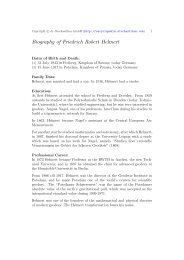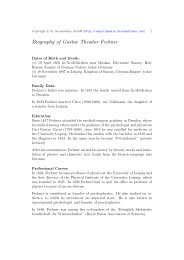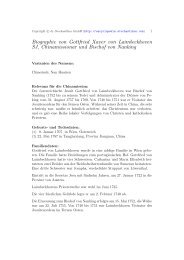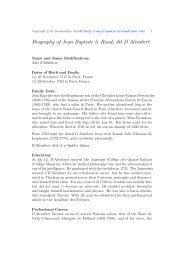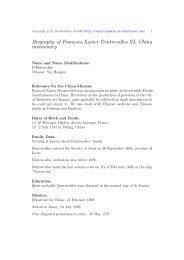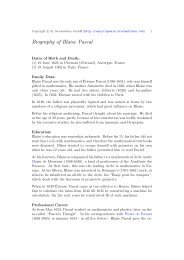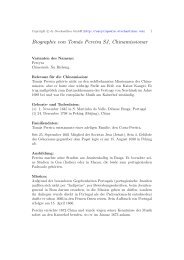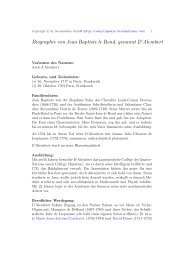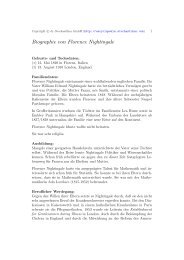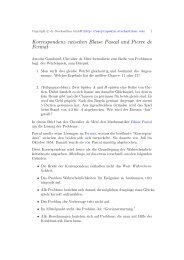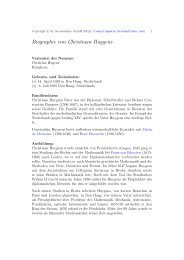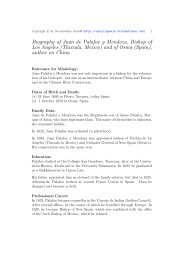Biography of Lu´ıs Cabrera y Sotelo OFM, Japan mis- sionary
Biography of Lu´ıs Cabrera y Sotelo OFM, Japan mis- sionary
Biography of Lu´ıs Cabrera y Sotelo OFM, Japan mis- sionary
Create successful ePaper yourself
Turn your PDF publications into a flip-book with our unique Google optimized e-Paper software.
Copyright c○ by Stochastikon GmbH (http://encyclopedia.stochastikon.com) 1<br />
<strong>Biography</strong> <strong>of</strong> Luís <strong>Cabrera</strong> y <strong>Sotelo</strong> <strong>OFM</strong>, <strong>Japan</strong> <strong>mis</strong><strong>sionary</strong><br />
Relevance for the <strong>Japan</strong> Mission:<br />
Luis <strong>Sotelo</strong> was an important <strong>Japan</strong> <strong>mis</strong><strong>sionary</strong> and martyr. In <strong>Japan</strong>, <strong>Sotelo</strong><br />
also gained great merits with the erection <strong>of</strong> hospitals.<br />
Dates <strong>of</strong> Birth and Death:<br />
(∗) 6 September 1574 in Sevilla, Spain<br />
(†) 25 August 1624 in Shimabara on Kyushu, <strong>Japan</strong><br />
Family Data:<br />
Luís <strong>Sotelo</strong> was the son <strong>of</strong> the Spanish nobleman Diego Caballero de <strong>Cabrera</strong><br />
and <strong>of</strong> his wife Catalina Nino <strong>Sotelo</strong>.<br />
<strong>Sotelo</strong> joined the Franciscan Convent “Calvario de los Hermanos Menores”<br />
on 11 May 1597.<br />
Education:<br />
<strong>Sotelo</strong> made his studies at the well-known University <strong>of</strong> Salamanca. He<br />
stopped his pro<strong>mis</strong>ing secular career to become a Franciscan.<br />
Pr<strong>of</strong>essional Career:<br />
As a Spanish Franciscan <strong>of</strong> the 16th and early 17th century, <strong>Sotelo</strong> belonged<br />
to the Spanish Patronato Real. To its sphere <strong>of</strong> influence belonged also<br />
the Philippines, whereas <strong>Japan</strong> and China belonged to the sphere <strong>of</strong> the<br />
Portuguese Padroado. In 1599, <strong>Sotelo</strong> travelled via Mexico to the Philippines,<br />
where he arrived in 1600. He took care <strong>of</strong> the <strong>Japan</strong>ese Christians <strong>of</strong> the<br />
settlement Dilao, which was destroyed by the Spaniards in 1608. <strong>Sotelo</strong><br />
wanted to go to the <strong>Japan</strong> <strong>mis</strong>sion and therefore he learnt <strong>Japan</strong>ese in his<br />
parish, but his <strong>of</strong>fice as a preacher and lector in Manila prevented him to<br />
travel to <strong>Japan</strong> before 1603.<br />
In <strong>Japan</strong>, <strong>Sotelo</strong> at first worked in Fushimi, where he gained many friends,<br />
among them the Daimyō Asano Yukinaga, and also could convert people to<br />
Christianity. Since 1608, he was as a <strong>mis</strong><strong>sionary</strong> in Osaka, then in Shikoku.<br />
He helped the legates from the Philippines with their negotiations for a treaty<br />
<strong>of</strong> friendship with the Tokugawa. In 1610, <strong>Sotelo</strong> worked as a <strong>mis</strong><strong>sionary</strong><br />
in Edo (today Tokyo), where he became a friend <strong>of</strong> the Daimyō (prince) <strong>of</strong>
Copyright c○ by Stochastikon GmbH (http://encyclopedia.stochastikon.com) 2<br />
Sendai, Date Masamune (1567-1636); with an edict dated 23 November 1611,<br />
the Daimyō permitted the free preaching <strong>of</strong> the Gospel and saved him from<br />
the starting persecution <strong>of</strong> Christianity in <strong>Japan</strong>. In 1610, Date Masamune<br />
sent him as a legate to New Spain (Mexico), <strong>Sotelo</strong> travelled on board <strong>of</strong> the<br />
ship “San Buena Ventura”, which had been built by the English adventurer<br />
William Adams (1564?-1620) for the Shōgun, together with 22 <strong>Japan</strong>ese. The<br />
Vice-King <strong>of</strong> Nueva-España sent him together with the Spanish discoverer<br />
Sebastián Vizcaíno (1548-1625) back to <strong>Japan</strong>. Vizcaíno and <strong>Sotelo</strong> arrived<br />
in <strong>Japan</strong> in 1611, but Vizcaíno behaved quite arrogant against the <strong>Japan</strong>ese.<br />
The Shōgun had built himself a galleon in the Spanish manner, the “San<br />
Juan Bautista” (the ship was completed in only 45 days), to bring Vizcaíno<br />
back to Mexico, Date Masamune was made the leader <strong>of</strong> the project. The<br />
<strong>Japan</strong> delegation was led by Hasekura Rokuemon Tsunenaga (1571-1622),<br />
a retainer <strong>of</strong> Date Masamune, captain was the samurai Yokozawa Shogen,<br />
<strong>Sotelo</strong> was the European companion. They started on 28 October 1613 together<br />
with 180 persons. The purpose <strong>of</strong> this delegation was among others to<br />
promote the trade relations between <strong>Japan</strong> and Spain, to promote <strong>mis</strong><strong>sionary</strong><br />
work, whereas <strong>Sotelo</strong> wanted to found a diocese in <strong>Japan</strong>, independent from<br />
Portugal and the Jesuits. First they travelled to Mexico, then via Spain to<br />
Rome.<br />
In Madrid, they were received in a very honorable way by king Philipp III,<br />
Hasekura Rakuemon Tsunenaga was baptized in Madrid on 17 February<br />
1617. They travelled via France to Rome, where they were received by pope<br />
Paul V. A second visit in Spain did not result in the desired trade relations,<br />
because the Spanish king had the impression that the delegation was not<br />
sent <strong>of</strong>ficially by the Shōgun. The pope appointed <strong>Sotelo</strong> Bishop <strong>of</strong> Northern<br />
Honshu, but the Spanish administration refused the necessary recognition because<br />
<strong>of</strong> the persecution <strong>of</strong> Christians in <strong>Japan</strong>, furthermore, <strong>Japan</strong> belonged<br />
to the sphere <strong>of</strong> influence <strong>of</strong> the Portuguese Padroado, which had a diocese<br />
in Funai (Nagasaki). Some <strong>of</strong> the <strong>Japan</strong>ese remained in Spain, the rest <strong>of</strong> the<br />
delegation started from Sevilla to Mexico in 1617. In 1618, <strong>Sotelo</strong> arrived on<br />
the Philippines, whereas Hasekura travelled to <strong>Japan</strong>. Hias report about Europe<br />
and the Spanish methods <strong>of</strong> colonialism surely contributed that <strong>Japan</strong><br />
stopped the commerce with Spain in 1623, and the diplomatic relations with<br />
Spain, in 1624, too.<br />
<strong>Sotelo</strong> also failed with his plans, to found a Franciscan custody in <strong>Japan</strong> independent<br />
from Manila, he even had to abandon the privileges he had gained<br />
in Rome and could not receive the bishop consecration. In 1620, he was sent<br />
back to Mexico. Only in 1622, he succeeded to return secretly from the
Copyright c○ by Stochastikon GmbH (http://encyclopedia.stochastikon.com) 3<br />
Philippines to <strong>Japan</strong> together with two friends. In the meantime, Christianity<br />
had been forbidden there, and <strong>Sotelo</strong> and his companions were delivered<br />
to the governor <strong>of</strong> Nagasaki. <strong>Sotelo</strong> was burnt on the stake together with<br />
the Dominican Pedro Vazquez (1590-1624) and the Jesuit Diego Carvalho<br />
(1578-1624). In 1867, he was beatified by Pius IX.<br />
Publications Luis <strong>Sotelo</strong>:<br />
• “Carta del B. Luís <strong>Sotelo</strong> O.F.M. al señor Obispo del Japón sobre la<br />
prisión y martirio de Juan Miboku y de sus compañeros, c. 1613”, in:<br />
Lorenzo Pérez, Apostolado y Martirio del B. Luís <strong>Sotelo</strong> (Madrid 1924)<br />
127-134.<br />
• Relacion Verdadera del recibimiento qve la santidad del Papa Paulo<br />
Quinto, y los mas Cardenales hizieron en Roma al Embaxador de los<br />
Japones que desta Ciudad de Seuilla partio el año passado (Sevilla<br />
1616), also printed in: Lorenzo Pérez (ed.), Apostolado y Martirio del<br />
B. Luís <strong>Sotelo</strong> (Madrid 1924) pp.272-274.<br />
• Relacion Verdadera qve embio el Padre Fray Luys <strong>Sotelo</strong> de la Orden<br />
de San Francisco... (Sevilla 1616), also in: Lorenzo Pérez (ed.), Apostolado<br />
y Martirio del B. Luís <strong>Sotelo</strong> (Madrid 1924) pp. 270-272.<br />
• “Capitulaciones. Las cosas que Fray Luís <strong>Sotelo</strong>, predicador general<br />
y co<strong>mis</strong>ario apostólico del Japón, propone y pide a nuestros carisimos<br />
hermanos Co<strong>mis</strong>ario de Visita y Difinidores desta sancta Provincia de<br />
San Gregorio de Philipinas de su parte y por la de dos demas religosos<br />
que se ocupan en la conversion del Japón, Manila, a 30 de Julio de<br />
1618”, in: Lorenzo Pérez (ed.), Apostolado y Martirio del B. Luís <strong>Sotelo</strong><br />
(Madrid 1924) pp. 194-197.<br />
• “Relación de la persecución de la religión cristiana en el Japón, escrit<br />
por el B. Luís <strong>Sotelo</strong> O.F.M., Dilao, 4 de Agosto de 1621”, in: Lorenzo<br />
Pérez (ed.), Apostolado y Martirio del B. Luís <strong>Sotelo</strong> (Madrid 1924)<br />
pp. 250-263.<br />
• “Carta del B. Luís <strong>Sotelo</strong> O,F.M. al P. Provincial y demás religiosos de<br />
la Provincia de San Gregorio, Vomura, Março de 1623”, in: Diego de<br />
San Francisco, Relaçión (Manila 1625) cap. XXIII, p. 126-128, Juan de<br />
San Antonio, Chronica de la Provincia de San Pablo, vol. II (Madrid<br />
1729) pp. 241-243, Lorenzo Pérez (ed.), Apostolado y Martirio del B.<br />
Luís <strong>Sotelo</strong> (Madrid 1924) pp. 230-233.
Copyright c○ by Stochastikon GmbH (http://encyclopedia.stochastikon.com) 4<br />
• “Litterae B. Ludovici <strong>Sotelo</strong> O.F.M. ad Urbanum VIII. De hoc carcere<br />
Iaponio Omurensi, 20. Januarii 1624”, in: Luís <strong>Sotelo</strong>, Fr. Lvdovici<br />
Soteli Minoritae Regii ad Apostolicam sedem Legati et Regni Oxensis<br />
Apostolici ac designati Martyris Ad Vrbanum VIII. Pont. Max. De Ecclesiae<br />
Iaponicae statu Relatio: Imperatoris Augusti, Principum, Electorum,<br />
omniumque statuum Imperii cuiusque Ordinis lectione digna<br />
(Madrid 1628; Frankfurt 1634) pp. 3-26, and in: La Morale Pratique<br />
des Jésuites, vol. II (Köln 1683) pp. 137-197, Luís <strong>Sotelo</strong>, Lettera di fra<br />
Lodovico <strong>Sotelo</strong> Francescano legato del Re Ossense del Giappone alla<br />
Sede Appostolica, e Missionario parimenti Apostolico in quel Regno, e<br />
glorioso Martire di Gesu Cristo diretta a N.S. Urbano VII. Sopra lo<br />
stato della Chiesa del Giappone (Venezia 1760), Annales de la société<br />
des soi-disans Jésuites, vol. II (Paris 1765) pp. 766-802, Léon Pagès,<br />
Histoire de la Religion Chrétienne au Japon, vol. II (Paris 1870) pp.<br />
137-161, Lorenzo Pérez (ed.), Apostolado y Martirio del B. Luís <strong>Sotelo</strong><br />
(Madrid 1924) pp. 295-315.<br />
• “Carta del B. Luís <strong>Sotelo</strong> al P. Diego de San Francisco y demás <strong>mis</strong>ioneros<br />
Franciscanos del Japón, in die Sancti Bartholomaei de 1624”,<br />
in: Diego de San Francisco, Relación (Manila 1625) pp. 124-125, Juan<br />
de San Antonio, Chronica de la Provincia de S. Pablo, vol. II (Madrid<br />
1739) pp. 244-246, Lorenzo Pérez (ed.), Apostolado y Martirio del B.<br />
Luís <strong>Sotelo</strong> (Madrid 1924) pp. 235-237.<br />
• Under the pseudonym Gaspar Schoppe (Scioppius): Fr. Lvdovici Soteli<br />
Minoritae Regii ad Apostolicam sedem Legati et Regni Oxensis Apostolici<br />
ac designati Martyris Ad Vrbanum VIII. Pont. Max. De Ecclesiae<br />
Iaponicae statu Relatio: Imperatoris Augusti, Principum, Electorum,<br />
omniumque statuum Imperii cuiusque Ordinis lectione digna<br />
(Madrid 1628; Frankfurt 1634).
Copyright c○ by Stochastikon GmbH (http://encyclopedia.stochastikon.com) 5<br />
Luis <strong>Sotelo</strong> Bibliography:<br />
• Robert Streit, Bibliotheca Missionum, vol. V (Freiburg 1929) pp. 397f.<br />
• Bernward H. Willeke, “Biographical Data on Early Franciscans in <strong>Japan</strong><br />
(1582-1640)”, Archivum Franciscanum Historicum LXXXIII (1990) pp. 182-<br />
185.<br />
• [Sciopione Amati,] Historia del regno di Voxv del Giappone, dell’antichita,<br />
nobilita, e vaore del svo re idate Masamvne, delli fvori, c’ha fatti alla Chrsitianità,<br />
e desiderio che tiene d’esser Christiano, e dell’aumento di nostra<br />
santa fede in quelle parti. E dell’ambasciata che hà inuiata alla Sta<br />
di N.S. Papa Paolo V. e delli sujoi successi, con altre varie cose di edificatione,<br />
e gusto spiriuale de i lettori (Roma 1615), German: Relation<br />
und gründtlicher Bericht deß Königreichs Voxu im Japonischen Keyserthumb<br />
gottseliger Bekehrung, vnd dessentwegen außgefertigeter Ambasciada an Päbst:<br />
Heil. gen Rom Paulum den Fünfften, vnnd an die Cathol: May: Philip: den<br />
Dritten König in Hispania &c (Ingolstatt 1617; other translation: Rottweil<br />
1617).<br />
• C.R. Boxer, The Christian Century in <strong>Japan</strong> 1549-1650 (Berkeley 1967).<br />
• Otis Cary, A History <strong>of</strong> Christianity in <strong>Japan</strong> (Rutland, Tokyo 2000).<br />
• P.F. Charlevoix, Histoire et déscription to Japon, vol. II (Paris 1736).<br />
• Hubert Cieslik, “Die kirchliche Hierarchie in der alten <strong>Japan</strong><strong>mis</strong>sion”, Neue<br />
Zeitschrift für Missionswissenschaft XVIII (1962) pp. 42ff, 81ff, 177ff.<br />
• Shusaku Endo, Samurai (1980), German: Der Samurai (1987, 1990).<br />
• Neil S. Fujita, <strong>Japan</strong>’s encounter with Christianity. The Catholic Mission<br />
in pre-modern <strong>Japan</strong> (New York 1991).<br />
• Gerhard Huber, Der selige Ludwig <strong>Sotelo</strong>, Märtyrer aus dem Franziskanerorden<br />
(Werl 1937).<br />
• Félix de Huerta, Estado geográfico, topográfico, estadístico, histórico-religioso<br />
de la santa y apostólica Provincia de San Gregorio Magno (1865) pp. 392-<br />
394.<br />
• Marcellino da Civezza, Storia universale delle Missioni Francescane, vol.<br />
VII (Prato 1891).<br />
• Marcellinio da Civezza, Solenne Ambasceria dal Giappone al Sommo Pontifice<br />
Paolo V affidata al Francescanp Padre Luigi <strong>Sotelo</strong>... (Prato 1891).<br />
• Francis Marcouin, Keiko Omoto, Quand le Japon s’ouvrit au monde (Paris<br />
1990).<br />
• Louis Pagès, Histoire de la religion chrétienne au Japon, vol. 1 (Paris<br />
1869).<br />
• Lorenzo Pérez, Apostolado y Martirio del Beato Lluis <strong>Sotelo</strong> en el Japón<br />
(1924).<br />
• Dorotheus Schilling, “Zwei unveröffentlichte Briefe des seligen Ludwig
Copyright c○ by Stochastikon GmbH (http://encyclopedia.stochastikon.com) 6<br />
<strong>Sotelo</strong>, O.F.M.”, Antonianum XX (1945) pp. 127-148.<br />
• Giuseppe Pittau, Da Sendai a Roma. Un’ambasceria giapponese a Paolo<br />
V. (Roma 1990).<br />
• Juan Ruiz-de-Medina, El Martirologio del Japón 1558-1873 (Bibliotheca<br />
Instituti Historici S.I. vol. LI) (Roma 1999).<br />
• Dorotheus Schilling, “Hospitäler der Franziskaner in Miyako (1594-1597)”,<br />
Neue Zeischrift für Missionswissenschaft V (1949) pp. 1-18; 98-110; 189-202;<br />
258-275; VI (1950) pp. 35-47.<br />
• Dorotheus Schilling, “Die Missionen der spanischen Franziskaner in <strong>Japan</strong><br />
(1593-1639)”, Thuringia Franciscana 25 (1970) pp. 107-128; 261-283.<br />
• Arcadio Schwade, “Die Frühgeschichte des Christentums in <strong>Japan</strong> im Überblick”,<br />
in: Adrian Hsia, Ruprecht Wimmer (eds.), Mission und Theater. <strong>Japan</strong> und<br />
China auf den Bühnen der Gesellschaft Jesu (Jesuitica 7) (Regensburg 2005)<br />
pp. 289-353;<br />
• Thomas Uyttenbroeck, Early Franciscans in <strong>Japan</strong> (Himeji 1958).<br />
• Bernwardus H. Willeke, “Japonia”, in: Historia Missionum Ordinis Fratrum<br />
Minorum. I. Asia Centro-Orientalis et Oceania (Romae 1967) pp. 197-217.<br />
• Bernward H. Willeke, “Notizen zur Geschichte des alten Franziskanerklosters<br />
zu Fushimi in <strong>Japan</strong> (1602-1614)”, Franziskanische Studien 68 (1987)<br />
pp. 261-271.<br />
• Bernward H. Willeke, “Das Franziskanerkloster im alten Edo (Tokyo)”,<br />
Franziskanische Studien 73 (1991) pp. 208-226.<br />
• http://www.datemasamune.com/ (07.08.2009).<br />
• http://de.wikipedia.org/wiki/Hasekura Tsunenaga (07 August 2009).<br />
Author(s) <strong>of</strong> this contribution:<br />
Claudia von Collani<br />
Version: 1.00




